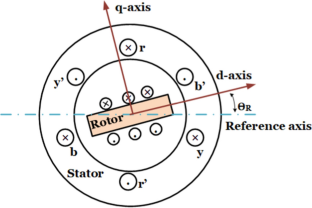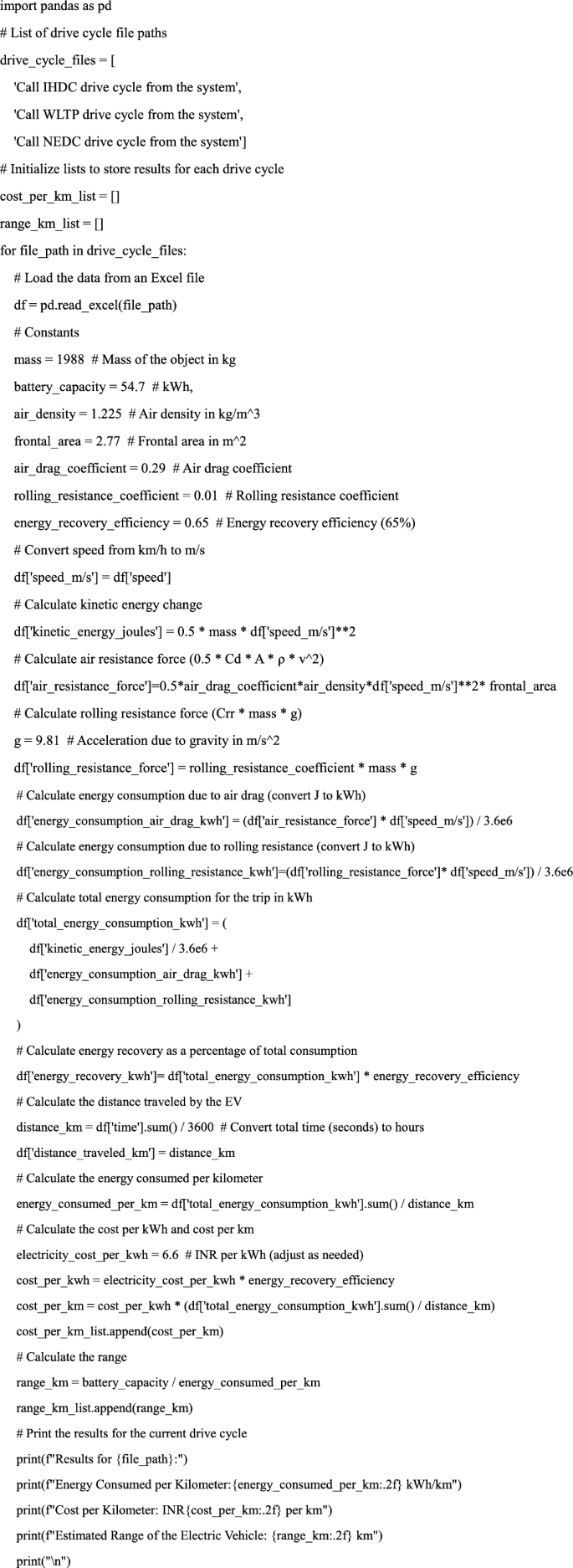Abstract
This paper presents a comprehensive analysis of an Externally Excited Synchronous Motor (EESM) integrated with sensorless Field-Oriented Control (FOC) using the stator and rotor mutual inductance method focusing on its impact on electric vehicle (EV) performance, energy efficiency, and optimization considerations. The investigation on the performance analysis of the EV shows that there is an improvement in the performance of the EV in terms of the efficiency of the three-phase Voltage Source Inverter (VSI) as 95.23, 95.07, and 94.51% across IHDC, WLTP, and NEDC drive cycles respectively. The efficiency of the traction motor, EESM, is 89.61, 89.92, and 88.46% for the same cycles, highlighting the efficacy of sensorless FOC in optimizing power and energy consumption. The research analysis reveals that the energy consumption rates of 280, 190, and 140 W/km for IHDC, WLTP, and NEDC cycles, with corresponding running costs of 1.19, 0.81, and 0.59 INR/km respectively. The analysis also uncovers driving ranges, with IHDC offering a maximum of 197 km, while WLTP and NEDC provide 290 and 400 km respectively. Additionally, the research study evaluates greenhouse gas emissions, with EESM-based EVs demonstrating substantial emission reductions. Specifically, IHDC records emissions of 198.8 g/km, WLTP at 134.9 g/km, and NEDC at 99.4 g/km, compared to 158.7 g/km for petrol cars and 145.25 g/km for diesel cars respectively. This research highlights the potential of EESM-based EVs with sensorless FOC control to enhance efficiency, reduced energy consumption and reduce emissions, making them a promising choice for sustainable transportation. The proposed research work carried out using Matlab/Simulink and results are presented to validate the proposed work.

































Similar content being viewed by others
Abbreviations
- EESM:
-
Electrically or externally excited synchronous motor
- GHG:
-
Greenhouse gas
- FOC:
-
Field-oriented control
- EV:
-
Electric vehicle
- VSI:
-
Voltage source inverter
- IHDC:
-
Indian highway drive cycle
- WLTP:
-
Worldwide harmonized light vehicles test procedure
- NEDC:
-
New european driving cycle
- PMSM:
-
Permanent magnet synchronous motor
- HFI:
-
High-frequency signal injection
- EMI:
-
Electromagnetic interference
- EKF:
-
Extended kalman filter
- RWDC:
-
Real-world driving cycle
- ICEV:
-
Internal combustion engine vehicle
- ML:
-
Machine learning
- SVPWM:
-
Space vector pulse width modulation
- INR:
-
Indian rupees
References
Approved_report_emission__2021_22.pdf (2022) https://cea.nic.in/wp-content/uploads/baseline/2023/01/Approved_report_emission__2021_22.pdf.
Ayub M et al (2020) Wye-delta winding configuration for brushless operation of a wound field synchronous machine. Int J Appl Electromagn Mech 64(1–4):1165–1172. https://doi.org/10.3233/JAE-209433
Choi G, Bramerdorfer G (2022) Comprehensive design and analysis of an interior permanent magnet synchronous machine for light-duty passenger EVs. IEEE Access 10:819–831
Chung HB, Kennel R (2020) ‘PWM-based sensorless control of electrically excited synchronous machine using mutual inductance’, In: 2020 International Symposium on Power Electronics, Electrical Drives, Automation and Motion, SPEEDAM 2020, pp 232–236. https://doi.org/10.1109/SPEEDAM48782.2020.9161944.
Dursun M (2023) Enhancement fractional-order sliding mode controller design for induction motor vector control. Iran J Sci Technol Trans Electr Eng 47(3):1059–1080. https://doi.org/10.1007/s40998-023-00637-2
Ghule AN, Killeen P, Ludois DC (2021) Sensorless control of separately excited synchronous electrostatic machines. IEEE Trans Ind Appl 57(4):3744–3753. https://doi.org/10.1109/TIA.2021.3076419
Home charging calculator (2024)
Hussain A et al (2022) Wound rotor synchronous motor as promising solution for traction applications. Electronics (switzerland) 11(24):1–16. https://doi.org/10.3390/electronics11244116
Huynh TA, Chen PH, Hsieh MF (2022) Analysis and comparison of operational characteristics of electric vehicle traction units combining two different types of motors. IEEE Trans Veh Technol 71(6):5727–5742. https://doi.org/10.1109/TVT.2022.3179868
Huynh TA, Hsieh MF (2018) Performance analysis of permanent magnet motors for electric vehicles (EV) traction considering driving cycles. Energies. https://doi.org/10.3390/en11061385
IOCL fuel price (2024).
Kim D-M et al (2020) Design of traction motor for mitigating energy consumption of light electric vehicle considering material properties and drive cycles. Int J Automot Technol 21(6):1391–1399. https://doi.org/10.1007/s12239-020-0131-7
Koteich M, Messali A, Daurelle S (2017) ‘Self-sensing control of the externally-excited synchronous machine for electric vehicle traction application’, In: Conference Proceedings - 2017 8th International Symposium on Sensorless Control for Electrical Drives, SLED 2017, pp 91–96. https://doi.org/10.1109/SLED.2017.8078436
Krause PC, Wasynczuk O, Sudhoff SD (2002) Analysis of electric machinery and drive systems. IEEE Press, NewYork
Liu C et al (2021) A critical review of advanced electric machines and control strategies for electric vehicles. Proc IEEE 109(6):1004–1028. https://doi.org/10.1109/JPROC.2020.3041417
Mahindra Xuv specifications no date. https://auto.mahindra.com/suv/xuv300 Accessed: 18 January 2024
Moujahed M et al (2018) Sensorless speed control and high-performance fault diagnosis in vsi-fed pmsm motor drive under open-phase fault: analysis and experiments. Iran J Sci Technol Trans Electr Eng 42(4):419–428. https://doi.org/10.1007/s40998-018-0088-y
Pravallika G, Sujatha P, Bharath Kumar P (2023) ‘Different traction motor topologies with lithium-air battery for electric vehicles: a review’, In: Materials Today: Proceedings, (xxxx), pp 3–6. https://doi.org/10.1016/j.matpr.2023.03.400
Renault (2017) ‘Renault Zoe’, Ideal.Es/Granada, February, pp 5–7
Ruuskanen V et al (2015) Drive cycle analysis of a permanent-magnet traction motor based on magnetostatic finite-element analysis. IEEE Trans Veh Technol 64(3):1249–1254. https://doi.org/10.1109/TVT.2014.2329014
Singirikonda S, Yeddula Pedda O (2023) Investigation on performance evaluation of electric vehicle batteries under different drive cycles. J Energy Storage 63:106966. https://doi.org/10.1016/j.est.2023.106966
Yang Y et al (2017) Design and comparison of interior permanent magnet motor topologies for traction applications. IEEE Trans Transp Electr 3(1):86–97. https://doi.org/10.1109/TTE.2016.2614972
Yang Z et al (2015) Comparative study of interior permanent magnet, induction, and switched reluctance motor drives for EV and HEV applications. IEEE Trans Transp Electr 1(3):245–254. https://doi.org/10.1109/TTE.2015.2470092
Zhang J et al (2020) Design and analysis of a low-speed and high-torque dual-stator permanent magnet motor with inner enhanced torque. IEEE Access 8:182984–182995. https://doi.org/10.1109/ACCESS.2020.3028425
Zhang X (2013) Sensorless Induction motor drive using indirect vector controller and sliding-mode observer for electric vehicles. IEEE Trans Veh Technol 62(7):3010–3018. https://doi.org/10.1109/TVT.2013.2251921
Zhu X, Cheng M (2010) Design, analysis and control of hybrid excited doubly salient stator-permanent-magnet motor. Sci China Technol Sci 53(1):188–199. https://doi.org/10.1007/s11431-009-0357-0
Funding
The research presented in this paper was conducted without any external funding.
Author information
Authors and Affiliations
Corresponding author
Ethics declarations
Conflict of interest
We have no conflicts of interest to disclose. All authors declare that they have no conflicts of interest.
Rights and permissions
Springer Nature or its licensor (e.g. a society or other partner) holds exclusive rights to this article under a publishing agreement with the author(s) or other rightsholder(s); author self-archiving of the accepted manuscript version of this article is solely governed by the terms of such publishing agreement and applicable law.
About this article
Cite this article
Paulraj, T., Obulesu, Y.P. Power and Energy Optimization in EV with Sensorless Externally Excited Synchronous Motor. Iran J Sci Technol Trans Electr Eng (2024). https://doi.org/10.1007/s40998-024-00714-0
Received:
Accepted:
Published:
DOI: https://doi.org/10.1007/s40998-024-00714-0





